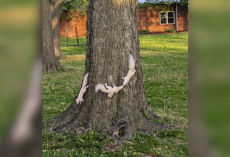Planet Earth and its nature are full of fascinating species and remarkable animals. It’s truly astonishing to see how different organisms interact and adapt to their surroundings to survive and maintain the balance within their ecosystem.
So when I came across pictures of three ”angry snakes” lurking in a tree, I naturally became curious. And I’m certainly not the only one who has been fooled by these incredible photographs.
Seeing one serpent in a tree can be terrifying enough, but three of them clustered together can make anyone’s blood run cold. But thankfully, it’s not actually snakes in the attention-grabbing images—it’s something entirely different…

There is immense biodiversity in nature, with millions of different species found all over the world. Each species has its own unique role and function within its ecosystem.
In addition to this, there are also incredible adaptations and survival strategies that many animals and plants have developed over the years. For example, some insects have camouflage colors to blend into their surroundings and avoid predators, while others have developed toxic substances for protection against enemies.
This fact became even more highlighted when pictures of three angry-looking ”snakes” started circulating on the internet. Back in 2021, a photo shared by Rob Allam on Twitter left users perplexed as it seemingly displayed three angry-looking ”serpents” hiding in a tree. However, it didn’t take long for users to realize that there was more to the story than meets the eye.

As it turns out, the trio of ”snakes” is nothing more than an optical illusion created by a section of wings belonging to two distinctive moth species, the Atlas moth.
This remarkable moth species, native to the forests of Asia, possesses a peculiar ability to mimic the appearance of a snake. With an impressive wingspan reaching up to 24 cm (9.4 in) and a wing surface area of approximately 160 cm2 (≈25 in2), the Atlas moth ranks among the largest Lepidoptera species.
The body of the Atlas moth is noticeably smaller in proportion to its wings, creating a striking contrast in size. It was first noted by Carl Linnaeus in 1758 and stands as one of the largest insects on the planet. Its name derivates from Atlas, the Titan of Greek mythology, owing to its substantial size.

When Twitter user Rob shared the viral picture, he also provided an explanation:
”Attacus Atlas is among the largest butterflies worldwide, and during its adult stage, it lives only for a brief span of two weeks. Its primary objective during this stage is to lay eggs and safeguard them until they hatch, all the while camouflaging itself as a snake,” he wrote.
A lot of people on social media initially struggled to believe that the creature in question was indeed a moth.
“That disguise is really good,” one user wrote.
Another user expressed surprise, saying, ”How’s that top one not an actual snake? This moth would live longer if it didn’t look like I wanted to beat it with a broom.”
Contrary to what one might assume, Atlas moths are actually weak and unsteady fliers. To conserve their energy, these moths prefer to rest during the daytime and become active flyers during the night.

When the Atlas moth feels threatened, it employs a defense mechanism by descending to the ground and engaging in a writhing motion while simultaneously flapping its wings in a deliberate manner to mimic the appearance of a snake’s head, according to National History Museum.
To witness the awe-inspiring presence of the Atlas moth firsthand, one would likely need to visit the tropical forests of Asia. However, there have been documented sightings of Atlas moths in certain regions of Europe and the United States as well.
In 2012, an intriguing incident was reported by the BBC, stating that a giant Atlas moth had been spotted on a windowsill in Ramsbottom, Greater Manchester. The moth was of such substantial size that the family who made the discovery initially mistook it for a bat. It is believed that the unique creature had likely escaped from a private collection. Sadly, it died shortly after being found.

In a truly momentous event, another Atlas moth specimen was captured on camera in Bellevue, Washington, in July 2022. This marked an extraordinary occasion as it was the very first documented instance of this species being sighted in the United States. In 2022, another one was found in Sweden as well.
“This is a ‘gee-whiz’ type of insect, because it is so large,” said Sven Spichiger, the managing entomologist for the state Agriculture Department told NBC News. ‘
He added, “Even if you aren’t on the lookout for insects, this is the type that people get their phones out and take a picture of — they are that striking.”

If I were to encounter this extraordinary creature, I would likely be filled with awe and amazement. My immediate instinct would be to reach for my camera and capture the moment, wanting to preserve it as a memorable experience. However, if I noticed it beginning to mimic a snake’s head, I would keep a safe distance...
It would be wonderful if you could share this article on Facebook, allowing more people to learn about this gigantic and impressive moth. Its remarkable characteristics and its rare occurrence outside its natural habitat are truly worth highlighting and appreciating!
READ MORE
- These bats look terrifying – but they’re gentle creatures struggling to survive poaching
- River ‘monster’ with enormous ‘bear-like’ claws terrifies mother and daughter











